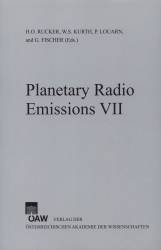
Planetary Radio Emissions VII, pp. 167-176, 2011/12/28
Proceedings of the 7th International Workshop on Planetary, Solar and Heliospheric Radio Emissions held at Graz, Austria, September 15–17, 2010

The relationship between Jupiter’s decametric (DAM) and hectometric (HOM) radio emissions is important to help understand the emission mechanism that both of them have in common, but it has remained an elusive enigma. We have investigated Jovian DAM and HOM emissions observed by the Cassini, Voyager 1 and Voyager 2 spacecraft. We made a statistical comparison of Cassini and combined Voyager 1 and 2 data for occurrence probability histograms in Central Meridian Longitude (CML) and in Io phase from 2 to 16 MHz, and a statistical analysis of Jovian HOM polarization plotted as a function of Jovian magnetic latitude and frequency below 3 MHz based on only the Cassini data. We found that (1) the position of Source B shows shifts in longitude from 10 to 16 MHz as seen in both Cassini and combined Voyager 1 and 2 data, (2) the effect of Io can be seen down to 4 MHz, (3) the occurrence probability of HOM emissions are separated into right- and lefthand polarization senses, and (4) attenuation bands make a large contribution to intensify the HOM emissions around the attenuated regions.